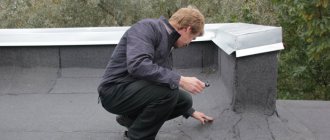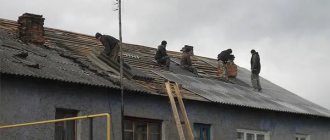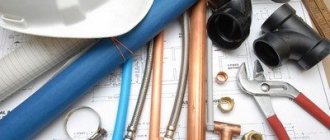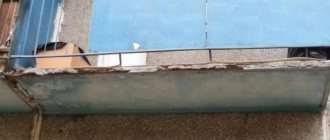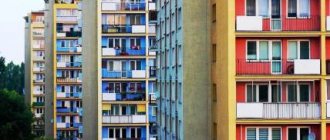What is included and at whose expense is a major overhaul carried out?
Today, major renovations of apartment buildings are of concern to residents, the government, and management companies. This is a serious problem closely related to the state of the housing stock and public interest in it. The 2014 Law on Major Repairs ensured the safety and comfort of living in apartment buildings by establishing deadlines for the completion of restoration work.
Who pays for major repairs
A few words about who should pay for the overhaul of a residential building. The law on major repairs of apartment buildings (Article 169 of the Housing Code of the Russian Federation) clearly distinguishes who carries out the work and how.
Local authorities are responsible for organizing and controlling the overhaul, and the owners collect money for it. Before this, financial issues were handled by the Housing and Utilities Reform Fund, which today carries out work resettling residents from dilapidated and dilapidated houses.
Payment for the capital repair program for apartment buildings is included in the monthly ENP and is determined for each locality individually.
Residents are exempt from paying for major repairs:
- emergency houses;
- houses standing on land included in state ownership;
- apartments owned by municipalities.
The amount of contributions is calculated based on average income indicators and is about 9 rubles per square meter, the amount depends on the category of the house. Residents of municipal apartments are deprived of the right to vote in the HOA (homeowners' association) and do not have the right to make any proposals for organizing and carrying out major repairs.
Overhaul Fund
A major home renovation should eliminate structural deficiencies in the housing stock. Also, the work can improve the properties of buildings. Periodic maintenance is required to help eliminate minor damage and prevent wear and tear on the foundation. These are usually planned repairs that do not require large financial costs and disconnecting the house from the hot water supply.
To carry out the work, a capital repair fund must be organized, consisting of contributions and interest on them, which is used to pay for several works. Thus, the program for major repairs of common residential property is carried out with money from this fund.
It is also possible to make payments on loans taken out to provide the necessary services, and to pay the developers of project documentation. If the housing is in poor condition, funds are allocated for restoration work or to pay for demolition. This decision must be made by apartment owners at a meeting.
When carrying out additional work on the improvement of the building, the HOA may set an increased contribution rate.
List of major repair works
The money contributed to the capital repair fund by the owners of apartment buildings can be spent on many needs for the repair and restoration of housing. What is included in the major renovation of an apartment building? Repair of walls and facades is the main work during a major overhaul. They allow:
- carry out repairs and insulation of facades and plinths;
- glazing balconies and loggias;
- replace windows and balcony blocks for greater noise insulation;
- replace or repair the drainage system;
- repair house fire escapes;
- restore or replace roofing;
- repair house canopies;
- repair the blind area;
- repair the external walls of elevators.
restoring the basement and foundation also applies to the overhaul of an apartment building . To do this, money is taken from the overhaul fund to:
- repair the foundation of the house;
- treat the structural elements of the building with an antiseptic;
- repair entrances to basements;
- carry out hermetic work on interpanel seams, etc.
The next stage of each major renovation is the restoration and restoration of the roof and attics . To do this you need:
- repair the attic and roof, carry out fireproofing treatment;
- treat all wooden beams with antiseptic agents;
- repair or replace pallets;
- normalize temperature;
- carry out sealing and repair work on ventilation systems;
- repair or replace parapet gratings;
- replace or repair drainpipes, etc.
Carrying out major repairs will not take place without restoring the stairs with changing steps and railings . Restoration of common areas in the entrance and entrance doors is also necessary ; these works are classified as major repairs. To do this you need:
- repair lighting in the entrance;
- repair or replace door structures;
- repair garbage chute hatches, etc.
The overhaul of an apartment building includes work to recreate engineering communications . The management company must:
- repair the ventilation system;
- repair and replace the hot and cold water supply system;
- repair sewer and drainage equipment;
- repair the building's gas supply, electrical equipment, and fire protection system.
The work also includes: repair of garbage chutes, elevator equipment, improvement of the local area, finishing of walls and ceilings in entrances in case of damage. All of the above answers the question of what work is included in a major overhaul.
Who may not pay
Having learned what is included in the list of overhaul works, you need to find out who may not pay the fee. These are, first of all, tenants who do not have rights to the apartment or room in which they live.
These include citizens who have entered into a lease or social tenancy agreement. This also includes persons sharing housing with the owner.
People who own non-residential premises in a house are not exempt from paying contributions.
Payment of fees
Many people doubt whether it is necessary to pay for major repairs of residential buildings? Yes, you will have to pay in any case. If this is not done, then penalties cannot be avoided, which may be claimed in court by the management company. The court always satisfies such claims and obliges the debtor to pay the debt.
If there are unpaid financial obligations, the defaulter may be deprived of the right to travel abroad, be prohibited from entering into real estate transactions, and may even be subject to seizure of property. With housing and communal services debts, any citizen is deprived of benefits for utilities.
Money to create a fund may also come from other sources. In this case, funds can be used not only to pay off existing debts, but also to pay for additional work. Other sources include financial resources paid for the rental of non-residential premises and advertising placed in the building. In this case, discounts on payments for pensioners and veterans may be given.
Quality of repair
The company carrying out the repair work will monitor the quality in accordance with all requirements. Contractual obligations define standards for major repairs and safe indicators corresponding to the work carried out on home improvement.
Progress is monitored either by a regional operator or by a homeowners association. State bodies are also involved in control over the overhaul.
While performing work, they are required to draw up lists of notifications and special accounts, and inform residents about all activities carried out.
Conclusion
Having found out what is included in the overhaul list, we can draw some conclusions. For example, the capital improvement program is financed through a special fund, partly consisting of contributions from owners.
The timing depends on the service life of the materials included in the housing stock. Thus, a slate roof will become unusable after 30 years, and a cast iron pipeline will deteriorate after 40 years.
Payment of contributions is mandatory for all residents; in case of arrears, court proceedings and penalties will be charged.
Source: https://ozhkh.ru/mnogokvartirnyj-dom/chto-vhodit-v-kapitalnyj-remont-mnogokvartirnogo-doma
The Prosecutor General's Office declared fees for major repairs unconstitutional
The Prosecutor General's Office agreed with the arguments of deputies of the A Just Russia party regarding the illegality of fees for major repairs of apartment buildings.
The party reports that the Prosecutor General's Office considers the applicants' arguments about the inequality of the position of the owners who form the capital repair fund on the account of the regional operator, and the citizens who collect these funds in a special bank account, to be justified.
The contested norm does not specify the volumes and terms of disposal of financial resources and does not determine the procedure for their return, which may create conditions under which the owners of the premises will not be able to manage the money transferred to the operator’s account. This leads to a violation of the Constitution, says the review from the Prosecutor General’s Office. In turn, the Commissioner for Human Rights in the Russian Federation, Ella Pamfilova, emphasizes that operators, by transferring money collected in one house for repairs in another, are essentially using, without permission, the funds of some owners to fulfill obligations to others.
Previously, bill No. 986339-6 was introduced to the State Duma, aimed at creating alternative options for financing the overhaul of common property in apartment buildings.
It is proposed to provide the owner with the right to voluntarily choose the following methods of financing: formation of a capital repair fund; general property insurance and one-time cash charges.
Major repairs of common property in an apartment building
common property of an apartment building (MKD) is the direct responsibility of the owners of residential and non-residential premises. Every month, property owners pay for the services of a management company (MC) to carry out routine repairs, and also transfer contributions for major repairs to regional funds.
By “major” we mean repairs of: the roof, basement, engineering systems, elevator equipment and shafts, as well as the facade and foundation.
The amount of payment for repair work is established by a regulatory act of the government authority. The funds paid by the owners are stored in a special fund. The funds received finance repair work in the apartment building.
What is included in the common property of an apartment building and features of its renovation
In accordance with Article 36 of the Housing Code of the Russian Federation, common property in MKD means:
- Premises that are not parts of apartments and are intended to serve more than one room in the house (for example, an elevator, staircases, inter-apartment landings, shafts, basements, attics).
- The plot of land on which the house is located, with elements of landscaping and landscaping.
- Premises that do not belong to any of the owners and are intended for social and cultural leisure of residents.
- Roof , load-bearing and non-load-bearing structures of the building.
- Mechanical, engineering, plumbing equipment that serves more than one room.
Apartment owners can dispose of common property only jointly .
They do not have the right to sell their share or dispose of it in any other way separately from the apartment - a share of the common property can pass to another owner only together with the housing. In accordance with clause 1.
158 of the Housing Code of the Russian Federation, owners in apartment buildings bear the costs of maintaining their housing by paying a fee :
- for maintenance and current repairs;
- for major repairs.
Current repairs include work to maintain the apartment building in a favorable condition . For example, replacing glazing in the entrance, repairing stairs and railings, carrying out cosmetic repairs, and eliminating minor faults. Unlike major repairs, fewer requirements are established for current repairs, they are less expensive and require less time to carry out.
Work related to improving the condition of the building, as well as replacing and reinstalling its worn parts, is included in the list of expenses for major repairs.
Every month, apartment owners in apartment buildings are required to pay the costs of major repairs. The amount of the fee is established by the regulatory act of the constituent entity of the Russian Federation and depends on the technical characteristics of the building, as well as on the square area of the housing (Article 169 of the Housing Code of the Russian Federation).
Technical regulations for the overhaul of the roof of an apartment building
The overhaul of the roof of an apartment building includes the following work:
- for the complete restoration of all properties of the roofing (hydro-, noise- and thermal insulation);
- repair of the drainage system, joints of floor slabs, as well as the junction of the roof with the eaves;
- restoration of ventilation shafts and wooden structures.
During the overhaul process, outdated materials are replaced with modern ones in order to extend further operation. Work is carried out once every 10-50 years , depending on the type of roof, provided that more than 40% of the coating . The timing of the work and its cost significantly exceed the costs of partial repairs.
Coordination of repair work is carried out by the management company; engineering specialists accept the work and conduct technical supervision over the progress of its implementation. After completing a major roof repair, the company that carried out the work issues a warranty document , which indicates the service life of the repaired roof.
Major renovation of the facade of an apartment building
The list of works for major repairs of the facade of an apartment building includes:
- Sealing cracks and eliminating leaks.
- Removing old coating, insulating walls and sealing joints.
- Cleaning from rust and fungal deposits.
- Applying plaster, laying tiles, stone.
- Replacement of drainpipes.
The work is aimed at completely restoring the facade, giving the house a new look. Major repairs are carried out once every 10 years , subject to the presence of the following defects:
- more than 30% was damaged ;
- The seams collapsed, the insulation layer completely crumbled;
- deformation of the gutters causes moisture to enter the walls.
The degree of destruction of the facade is determined by a special commission, which consists of an initiative group of residents and representatives of the regional operator. For each type of facade, a technological map with a list of building materials, as well as technology for performing repair work.
When carrying out major repairs of the facade:
- Leaks and malfunctions are eliminated, engineering structures are restored or replaced.
- Innovations and more efficient repair technologies are used.
- Safe, non-flammable materials are used.
Overhaul of the foundation of an apartment building
Major repairs of the foundation of an apartment building include the following list of works:
- strengthening the foundation, screed along the contour;
- updating the drainage system;
- cementation of cracks;
- elimination of local defects and deformations;
- repair of glued and coated foundation insulation;
- removal of destroyed layers;
- creating waterproofing.
Repair work consists of strengthening the foundation of the house, completely reconstructing the facade, and replacing damaged parts. Overhaul of the foundation is a technically complex task; the management company must regularly carry out cosmetic repairs of the foundation for preventive purposes every 5-10 years .
Replacement of elevators under the overhaul program
Replacement of elevator equipment is carried out as part of a major overhaul if a decision has been made to declare it unfit for use (clause 2, clause 3, article 15 of Federal Law No. 185 of July 21, 2007).
Before the start of work, a technical examination is carried out, as a result of which the operability of the elevator is determined.
Based on the results of the inspection, specialists prepare an expert report , which contains a list of all malfunctions of elevator equipment and shafts.
First of all, elevators whose service life has exceeded 25 years . Before the start of work, the management company must notify residents about the replacement of the elevator 6 months in advance . If there are several elevators in a building, replacement of equipment should be carried out in order of priority. Depending on the number of floors of the apartment building, replacement lasts up to 2 months .
The list of works for the overhaul of the basement and basements includes:
- Insulation of walls and basement floors.
- Floor repair.
- Installation of metal doors in basements.
- Repair of utility networks in external walls.
- Waterproofing walls and floors.
- Replacing the drainage system.
- Restoration of the blind area.
- Repair of vents and basement windows.
The scope of work for basement repairs may change at the design stage and coordination of the scope of work carried out with the owners. Owners of basements allocated for pharmacies, cafes, shops, etc., are obliged, along with other residents of the house , to bear the costs of maintaining common property, since basements are a constructive part of the apartment building.
At whose expense are repairs to common property carried out?
Contributions from property owners are the main source of financing for repair work to maintain common property in proper condition.
Monthly payments for major repairs, by decision of the owners, can be kept:
- On the account of the regional operator , the funds are managed by a special fund, which is obliged to provide major repairs to the house in accordance with the regional program adopted in the region. The authorities establish the priority of apartment buildings in which repair work will be carried out. The regional operator spends funds received from the owners of some apartment buildings for the repair of other houses, the owners of premises in which have also formed a capital repair fund on the account of the regional operator.
- In the MKD special account , funds are used only for major repairs in a specific house . You can only open an account in a Russian bank. Quarterly, the Central Bank posts information about such banks on its website. The owners themselves control the account. They are also responsible for organizing major repairs: developing technical documents, selecting and supervising contractors, and accepting work.
Partial financing of repair work can be carried out through the provision of subsidies from the state or municipal budget. Such support can be provided regardless of the method chosen by the owners to form the fund.
Owners of apartment buildings may decide to increase the amount of the contribution and expand the list of works that can be carried out for major repairs. For example, pay for construction control services or use funds to repay loans spent on major repairs.
Source: https://kvartirniy-expert.ru/kapremont-mkd/chto-vhodit/obshchee-imushchestvo/
According to Appendix 8 of Gosstroy Resolution No. 170 of September 27, 2003:
Appendix No. 8 (recommended)
SAMPLE LIST OF WORK PERFORMED DURING CAPITAL REPAIRS OF HOUSING STOCK
1. Inspection of residential buildings (including a complete inspection of the housing stock) and preparation of design estimates (regardless of the period of repair work).
2. Repair and construction work to replace, restore or replace elements of residential buildings (except for the complete replacement of stone and concrete foundations, load-bearing walls and frames).
Basement renovation
Basements in apartment buildings periodically need restoration. Communication systems and equipment represent a single organism that must function without failure. Therefore, repair activities are approached carefully, following the rules and using high quality materials
Why are basements needed?
According to current legislation, basements are classified as common property. It is not uncommon for the basement to play the role of a technical room, since the following are located there:
- engineering structures;
- communications;
- equipment.
The basement infrastructure includes heating, water supply and sewerage systems, electrical equipment, heat and electricity meters, hot water, and the base of the elevator shaft. Intervention in the activities of one or more systems will lead to irreversible consequences.
Therefore, bars are installed on basement windows, and door panels are made of iron and equipped with reliable locking mechanisms. The person in charge of the house elected at the general meeting, representatives of utility organizations and the management company are authorized to enter the basement.
Some basements are additionally equipped with utility rooms for technical departments.
It happens that owners of residential premises living on the lower floors place home storage in the basements for the winter or use them as a household warehouse. To do this you will need to obtain a special permit. Having received such permission, the homeowner can independently carry out repairs, insulate the floor, and convert the premises into a sauna, billiard room or gym.
Repaired or updated
The work carried out directly depends on the technical condition of the object and the purposes for which it is planned to be used.
If an inspection by authorized representatives shows that the communications are not damaged and the interior is dry, we can talk about updating the basement.
In this case, mold and dirt covering the walls and ceiling should be removed, defects should be repaired, and the surfaces should be plastered and puttied (painted if necessary). Sometimes it is necessary to replace doors or window units, pipes or sections thereof.
If the basement is in disrepair, it is impossible to do without a full renovation. They begin with waterproofing measures. This will help protect the room from the penetration of groundwater and exposure to aggressive environments. Materials used for waterproofing:
- mastic;
- building mixtures;
- substances with bentonite clay;
- roll materials.
Waterproofing is designed to protect walls and fittings from dampness, corrosion, penetration of water and cold. Therefore, the choice of waterproofing compounds is approached competently in order to protect the components of the structure and prevent the occurrence of accidents.
When repairing basements, waterproofing material is applied primarily to the walls on the outside of the building along the boundary between the soil and the surface. The level of waterproofing corresponds to the external blind area or is located above it. The surface is pre-cleaned.
Remove dust, dirt, old paint stains. Then they are leveled, primed and dried thoroughly: in summer - naturally, in winter - using a heat gun or lamp. These actions are carried out to ensure a tight fit of the waterproofing to the wall.
For reliability, waterproofing is placed inside the basement - from cement-based materials, which expand when hardened. Mastics with cement even fill microcracks, so moisture will not seep through the surface.
If the most thorough sanitary treatment against fungus is required, an injection method is used to administer the solution.
Sometimes it is necessary to insulate the walls. To do this, polymer films are mounted on them, then an insulating layer.
When renovating a basement, the walls are plastered with cement-sand compositions, to which modifying additives are added - liquid glass and others. The plaster is applied three times to level the surface and provide dense protection from groundwater.
Basement floors are treated with paints that have replaced bitumen mastics that have lost their elasticity over time. Today, bitumen-polymer and bitumen-rubber solutions are used. Before laying linoleum or tiles, impregnating or cast insulation is applied to the floor.
The second option is more reliable: the surface is completely filled with the solution to create a kind of “trough” with a single bottom and walls.
Premises equipment
Complex internal work is carried out by specialists who have access to them. First, the electrical wiring is changed. Mark the locations of the sockets and determine where the wires cannot be laid. It is better to choose fluorescent or daylight lamps.
After the electricity is installed, the sewer and other pipes are replaced. They do this carefully and carefully: even a minor leak can lead to an emergency, so you should be careful.
They move on to thermal insulation, which is installed in the form of heat-insulating foam plates or silicate plates on the outside of the building.
Internal walls and partitions made of wood or steel are selected and secured, not forgetting that the doors still need to be installed.
Finish the floors. They can be left concrete, covered with linoleum or carpeted. The most economical is the first option. For an aesthetic appearance, it is better to paint concrete.
The final steps are wallpapering, painting the walls, finishing the ceiling. Often there are no windows in basements, so when choosing materials you should focus on warm and light shades that will add natural light.
Conclusion
The basement is an important part of a residential building. The well-being of residents often depends on its appearance and condition. Therefore, it is necessary to carry out repair and restoration measures in a timely manner for the comfortable and safe living of people.
Source: https://18podyezdov.ru/obnovlenie-podvalnyh-pomeshhenij/
How to care
To ensure a long service life, buildings take preventative measures by constantly maintaining the foundation. They do not allow cutting or adding soil around the building. Keep the blind area in good condition. Do not allow moisture to accumulate near the building and flood the base.
The danger is posed by watering flowerbed plants in the absence of organized drainage, which leads to a rise in groundwater.
When carrying out excavation work (if a building is being built nearby or a pit is being dug), the safety of the foundation is monitored. Heavy building materials and equipment are not stored near the walls of the house.
The quality of the initial laying of the foundation during construction, areas of the foundation with weak soil, lack of underground ventilation, and faulty sewerage deserve special attention. All these are the reasons for foundation subsidence.
Spontaneous seizure of the basement
Often there is an illegal seizure of the basement of an apartment building. Most often, the reason for such offenses lies in the fact that the owners do not know that they are the owners of the technical floor, and also because of the instability in the country in the 90s. The problem is that “fake” owners stubbornly prove their rights to the technical floor, arguing that they have invested material resources for major repairs and redevelopment. But these arguments have no legal force, so residents of a multi-storey building can safely defend their rights.
Read more: Widow of a military man sanatorium and resort treatment
Filing a lawsuit in court will help restore justice in this case.
For what purposes is the basement used?
Despite the fact that the room is not considered the best, it is often used and improved to increase the usable area. What is the room used for:
- An additional bedroom can be made from the basement.
- Storage room for household tools and planting materials.
- Billiard room.
- A games room and much more - it all depends solely on your imagination.
Advice. Many people believe that renovations need to start with redevelopment or design, but this is not entirely correct.
- The first step is to have your local building authority inspect the building, which will issue a permit for renovation work, especially if it involves a basement in a public house. You can write an application to the housing and communal services department for basement repairs, the main thing is to do this before starting work, otherwise in case of refusal you will lose money.
- After this, you can begin to calculate the cost of all work and materials, create a design (
Normative base
To get the use of the basement of an apartment building, you should find out who has the right to occupy the technical floor and how to privatize non-residential space correctly, without breaking the law. The regulatory framework will help with this, which includes articles and laws that define the principles and main nuances of the distribution of basement space between residents of an apartment building.
According to Article 36 of the Housing Code, the technical floor is the common property of the owners of a multi-storey building, and residents can own, use and dispose of it. It is worth considering that reducing the basement during the reconstruction process can only be done with the consent of all citizens living in the apartment building.
This article of the Housing Code assumes that, by decision of all owners, premises with permitted common use can be transferred to the full ownership of other persons, if this does not violate the interests and rights of these citizens.
Art. 289 of the Civil Code of the Russian Federation implies that the basement of an apartment building is the joint property of the apartment owners, between whom legal relations regarding the technical floor are determined by the 6th and 9th articles of the Housing Code. Thus, each owner of housing space owns a share of basement premises, but their alienation is limited by Article 290 of the Civil Code of the Russian Federation, and use by 288.
Citizens must comply with Art. 30 LC duties and know that they have the right to create property partnerships in accordance with Article 291 of the Civil Code of the Russian Federation.
| № | Article | Name |
| 1 | 36 Residential Complex of the Russian Federation | Ownership rights to common property of premises owners in an apartment building |
Basic repair and finishing work
The specifics of the basement leaves its mark on the technology of work, the choice of building materials and determines the following general principles:
- availability of modern ventilation and insulation;
- equipment for convenient entry and safe stairs for descent;
- use of moisture-resistant and “breathable” materials (plasterboard, ceramic tiles, wood, stone).
If the basement is being renovated for an office, then you should take into account not only its future presentability, but also sanitary standards for long-term stays.
In this case, in addition to compliance with general principles, increased requirements are also imposed:
- ventilation and adequate lighting with noise levels within established standards;
- use of environmentally friendly finishing materials and calm colors;
- zoning of space providing comfortable working conditions.
More daring solutions are already present in the arrangement and design of restaurants, billiard rooms and basement clubs. The decoration uses bright combinations and shades, the interior is decorated with original structural elements and details.
What definition is given to this concept in the regulatory legal acts?
So, in the general understanding, a major overhaul means:
- carrying out a comprehensive restoration or replacement of worn-out elements of a residential building with stronger and more durable ones;
- improving its performance characteristics;
- implementation of economically feasible and technically feasible modernization, including the installation of devices for recording the consumption of water, gas, electricity, etc.
In this case, a major overhaul involves the replacement and restoration of individual elements of a building or entire structures that have become unusable under the influence of time, as well as the elimination of negative consequences caused by wear and tear.
